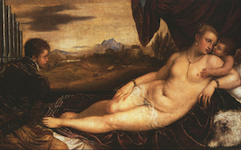Manet’s Boating (1874)
Manet's Boating is a masterpiece. It looks like one, hanging prominently in the Metropolitan Museum's Impressionist Galleries dominating the room. The viewpoint and scale of the picture make you pause. Contemporary critics were predictably hostile; Emile Zola, once Manet's champion, was so dismissive that he described Manet as "an excitable schoolboy, seeing clearly enough what is there in real life but unsure in his ability to render his impressions fully and definitively."1
Click next thumbnail to continue
What bothered Zola and the other critics were the "mistakes" Manet made in his presumed attempt to copy reality. "The background rises parallel to the picture plane"; there is little or no space between the boat and the water; despite the boat's angle, the woman is "in perfect profile perpendicular to the picture plane as if she were a cutout." To make matters worse, "the sail, the boom, and the rope appear to lie parallel to the picture plane" though the boat's angle and the position of the cleat indicate that this cannot be so.2
Click next thumbnail to continue
Before discussing Manet's meaning we must review his sources because a borrowed form always borrows meaning. They are highly important. It has never been noted, for example, that the man and woman are based on Goya's print after Velazquez's Bacchus (below). Manet had used the print in his portrait of Zola.3 In it Bacchus, legendary king of Spain and god of wine, symbolizes the imaginative power of Velazquez's mind. Manet, in turn, used Bacchus as the source for the boatman's torso, extended arms and head. The woman, too, lies like the laurel-wreathed man behind Bacchus, presumably a poet.4
Click next thumbnail to continue
As so often with Manet, there are other sources as well. The man's arm resting on the wooden rudder is probably taken from Velazquez's Prince Baltasar Carlos (1632), his hand resting on a wooden baton. It is a gesture of command and identifies the man with Velazquez's royal infant, newly initiated as a great master.
Click next thumbnail to continue
So the boatman now represents the "king" of Spanish art and, thus, Manet-as-Velazquez. He is posed like a painter just as Michelangelo's Jonah is on the Sistine ceiling.5 See how his arm crosses his torso to get paint from a palette. He will then, still in your imagination, turn back to the "canvas" to paint what we are looking at. The woman "perpendicular to the picture plane" has been painted. Descended from Bacchus and a laurel-wreathed poet they are both part of Manet's androgynous and poetic mind. The sail is parallel to the surface because it is, like the picture, a canvas. A "white rag" rests nearby to wipe it down.6
See conclusion below
What is striking about this interpretation is that all the features dismissed by critics in the past as being "errors" or "mistakes" - such as "the background rises parallel to the picture plane" - are actually integral to its meaning. They are neither wrong nor mistaken. Today's scholars have a different challenge since no-one now doubts that Boating is a masterpiece. Unable to explain the errors, they sometimes feel need to cite them as part of the artist's modern aesthetic, that is painting about nothing. Charles Moffett having criticized Zola for his failure to understand Manet's "precocious formal experimentation" cited Maurice Denis' remark that a painting - before it becomes a horse or a nude - "is essentially a flat surface covered with colors assembled in a certain order."7 Manet, he implies, spreads pigment for no other reason than to satisfy his eye. It becomes art without meaning which, to my mind, is a contradiction in terms. The bottom line here is that the man and woman are on different levels of reality fused into one scene within the artist's mind: he is the painter, she is painted.
Do read about other paintings in which the surface is a mirror with no imagined space for the viewer. They include significant masterpieces from Velazquez's Las Meninas to Manet's Olympia and Young Lady of 1866. Other examples are listed under the theme Mirrors.
More Works by Manet
See what Manet recognized in Titian and how we can then learn it from Manet

Titian’s Venus (c.1548-9) and Manet’s Olympia (1863)
Notes:
1. Emile Zola, Salons, ed. Fredrick W. J. Hemmings and Robert J. Niess (Geneva) 1959, p. 227
2. New York 1983, Manet (Metropolitan Museum of Art) p. 359
3. You can see the print in the top right corner affixed to a notice board. Manet, Portrait of Emile Zola (1868).
4. See S. Abrahams, Velazquez's Bacchus (c.1628-9). For more on Bacchus as the legendary king of Spain and this interpretation of Velazquez's Bacchus, see Steven N. Orso, "Los Borrachos" and Painting at the Court of King Philip IV (Cambridge University Press) 1993, pp. 97-108
5. See Abrahams, "Michelangelo's Art Through Michelangelo's Eyes" v.1, p. 12
6. A white rag is less well known as an artist's tool than a paintbrush, palette or even mahlstick. They are specifically made for artists. A rag (usually white) is essential as well for wiping unwanted pigment off the canvas or for gaining certain effects. Ingres can be seen using a rag in his principal hand in his only known youthful self-portrait in oil. Self-portraits by others often contain a rag on the side too.
7. New York 1983, p. 359
Original Publication Date on EPPH: 04 Jun 2012. | Updated: 0. © Simon Abrahams. Articles on this site are the copyright of Simon Abrahams. To use copyrighted material in print or other media for purposes beyond 'fair use', you must obtain permission from the copyright owner. Websites may link to this page without permission (please do) but may not reproduce the material on their own site without crediting Simon Abrahams and EPPH.







